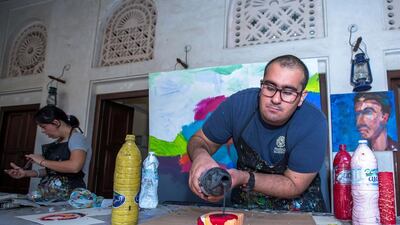DUBAI // Abdullah Lutfi sees the world differently from others. The Emirati artist captures vivid images in his paintings, sketches, sculptures that bear a distinctive, bold imprint of black-and-white lines.
“I see it in my head, I start with simple lines, black-and-white drawings. I see characters, sometimes it is pixilated. I like squares, lines,” says Lutfi, 23, who has autism.
“I like being an artist. I sign as AL. I wouldn’t mind having my own studio.”
Lutfi is part of a community of adults with disabilities at Mawaheb, an art studio in Dubai’s historical Al Fahidi neighbourhood.
His talent was discovered and nurtured in the studio’s sun-drenched courtyard and art rooms, where teachers encouraged him to use colours, work with mosaic, and create three-dimensional sculptures, while coaxing him to mix with others.
When gently prodded by art teacher Gulshan Kavarana about the feelings inspired by art, Lutfi lets out a very long sigh, “Again about feelings. Yes, I’m feeling everything … I like abstracts, I like mosaic.”
A visiting French artist has selected some of Lutfi’s trademark black-and-white sketches for possible display in a Paris gallery.
His paintings reflect life in the UAE – women in abayas with long eyelashes and men in white kaffiyeh (headscarf) with pointed beards.
One sketch depicts a skydiver hurtling down toward Dubai landmarks; another mirrors Sheikh Zayed Road traffic with a large lorry jostling for space with a high-end sports car and a KFC food delivery motorbike.
His line drawings were displayed in two shop windows at Bloomingdale’s in Dubai Mall this year showing daily life during Ramadan.
Lutfi worked with Spanish artist Rubin Sanchez on a Dubai artwork that was wrapped around a bus.
His sketches of the emirate’s skyline dominated by the Burj Al Arab and Burj Khalifa were chosen for a Sharjah children’s book of illustrations.
His mother, Amal Yousuf Baker, says the studio helps her son express his thoughts.
“Abdullah has made me famous. People ask me, ‘Are you the mother of Abdullah?’ and talk about his art,” Mrs Baker says.
But the initial years, when her son only drew and did not speak, were tough. Back then, there were no experts to diagnose Lutfi’s condition. A therapist in the UK identified him as autistic at the age of four, and recommended enrolment in a regular school.
Mrs Baker’s advice is to get children with disabilities out of the home to build their self esteem.
“I know mothers who don’t take their children out. But I did not hide Abdullah and took him to restaurants, coffee shops,” she says. “You must give time to the child, read up and speak to people. If you say – no, nothing is wrong, you will destroy the child. I was like a shadow and a parrot, I kept repeating everything to him.”
At Mawaheb, Lutfi initially kept people out of the room where he worked, saying he did not want to be disturbed. It took months to break through and get him interested in learning from sculptures and paintings other students were creating.
“He now gives drawing workshops and that is amazing for a person who has autism,” says Wemmy de Maaker, Mawaheb’s director. “He has loads of stories in his head and there is often a story behind his characters that he wants to share. The work he does is unique.”
Art and interacting with people has transformed Lutfi.
“Abdullah has this amazing power of retention,” says art teacher Ms Kavarana. “He does not have to look at photographs to remember. His visual perception is like Superman’s. He really can see things differently from us.”
rtalwar@thenational.ae


